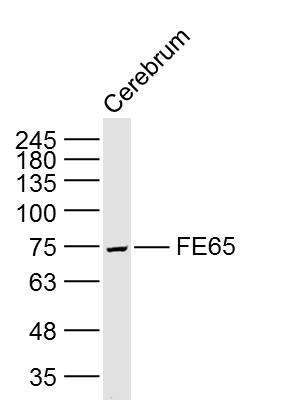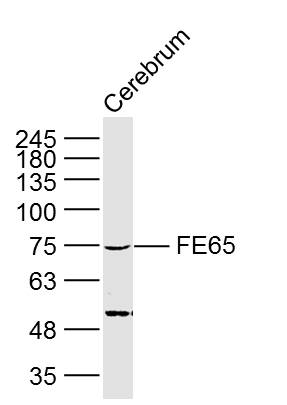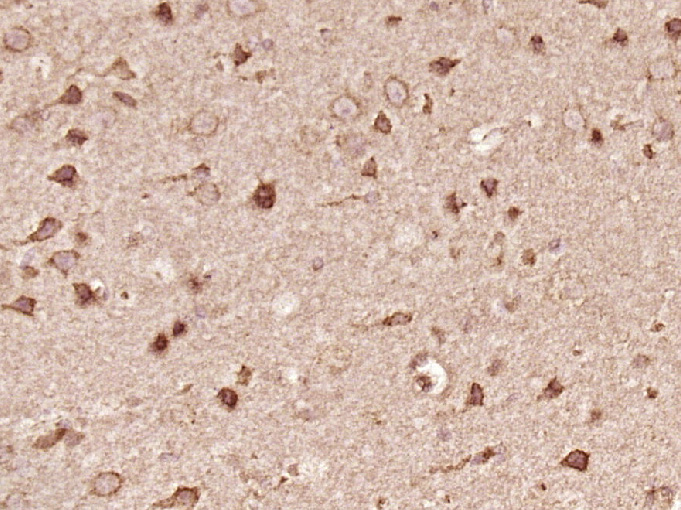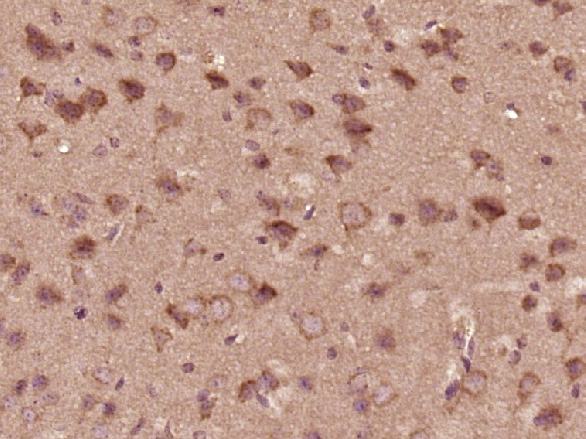
Rabbit Anti-FE65 antibody
Adaptor protein FE65a2; Amyloid beta (A4) precursor protein binding family B member 1; Amyloid beta A4 precursor protein binding family B; Amyloid beta A4 precursor protein binding family B member 1; Amyloid beta precursor protein binding family B member
View History [Clear]
Details
Product Name FE65 Chinese Name 铁蛋白Fe65抗体 Alias Adaptor protein FE65a2; Amyloid beta (A4) precursor protein binding family B member 1; Amyloid beta A4 precursor protein binding family B; Amyloid beta A4 precursor protein binding family B member 1; Amyloid beta precursor protein binding family B member 1; APBB 1; APBB1; FE 65; Fe65 protein; MGC 9072; MGC9072; Protein Fe65; RIR; Stat like protein; Fe-65 Protein; APBB1_HUMAN. Research Area Cardiovascular Signal transduction Growth factors and hormones transcriptional regulatory factor The new supersedes the old Immunogen Species Rabbit Clonality Polyclonal React Species Mouse, Rat, (predicted: Human, Rabbit, ) Applications WB=1:500-2000 ELISA=1:5000-10000 IHC-P=1:100-500 IHC-F=1:100-500 IF=1:100-500 (Paraffin sections need antigen repair)
not yet tested in other applications.
optimal dilutions/concentrations should be determined by the end user.Theoretical molecular weight 77kDa Cellular localization The nucleus cytoplasmic The cell membrane Form Liquid Concentration 1mg/ml immunogen KLH conjugated synthetic peptide derived from human Fe65: 201-300/710 Lsotype IgG Purification affinity purified by Protein A Buffer Solution 0.01M TBS(pH7.4) with 1% BSA, 0.03% Proclin300 and 50% Glycerol. Storage Shipped at 4℃. Store at -20 °C for one year. Avoid repeated freeze/thaw cycles. Attention This product as supplied is intended for research use only, not for use in human, therapeutic or diagnostic applications. PubMed PubMed Product Detail The protein encoded by this gene is a member of the Fe65 protein family. It is an adaptor protein localized in the nucleus. It interacts with the Alzheimer's disease amyloid precursor protein (APP), transcription factor CP2/LSF/LBP1 and the low-density lipoprotein receptor-related protein. APP functions as a cytosolic anchoring site that can prevent the gene product's nuclear translocation. This encoded protein could play an important role in the pathogenesis of Alzheimer's disease. It is thought to regulate transcription. Also it is observed to block cell cycle progression by downregulating thymidylate synthase expression. Multiple alternatively spliced transcript variants encoding different isoforms have been described for this gene. [provided by RefSeq, Mar 2012]
Function:
Transcription coregulator that can have both coactivator and corepressor functions. Adapter protein that forms a transcriptionally active complex with the gamma-secretase-derived amyloid precursor protein (APP) intracellular domain. Plays a central role in the response to DNA damage by translocating to the nucleus and inducing apoptosis. May act by specifically recognizing and binding histone H2AX phosphorylated on 'Tyr-142' (H2AXY142ph) at double-strand breaks (DSBs), recruiting other pro-apoptosis factors such as MAPK8/JNK1. Required for histone H4 acetylation at double-strand breaks (DSBs). Its ability to specifically bind modified histones and chromatin modifying enzymes such as KAT5/TIP60, probably explains its trancription activation activity. Function in association with TSHZ3, SET and HDAC factors as a transcriptional repressor, that inhibits the expression of CASP4. Associates with chromatin in a region surrounding the CASP4 transcriptional start site(s).
Subunit:
Component of a complex, at least composed of APBB1, RASD1/DEXRAS1 and APP. Interacts (via PID domain 2) with APP (with the intracellular domain of the beta-amyloid precursor protein). Interacts (via PID domain 2) with RASD1/DEXRAS1; impairs the trancription activation activity. Interacts (via PID domain 1) with KAT5/TIP60. Interacts (via the WW domain) with the proline-rich region of APBB1IP. Interacts with TSHZ1 and TSHZ2 (By similarity). Interacts (via the WW domain) with histone H2AX (when phosphorylated on 'Tyr-142') and the proline-rich region of ENAH. Interacts with MAPK8. Interacts (via PID domain 1) with TSHZ3 (via homeobox domain). Interacts with SET. Found in a trimeric complex with HDAC1 and TSHZ3; the interaction between HDAC1 and APBB1 is mediated by TSHZ3. Interacts (via WWW domain) with NEK6. Interacts (via WWW domain) with ABL1.
Subcellular Location:
Cell membrane. Cytoplasm. Nucleus. Cell projection, growth cone. Nucleus speckle. Note=Colocalizes with TSHZ3 in axonal growth cone. In normal conditions, it mainly localizes to the cytoplasm, while a small fraction is tethered to the cell membrane via its interaction with APP. Following exposure to DNA damaging agents, it is released from cell membrane and translocates to the nucleus. Nuclear translocation is under the regulation of APP. Colocalizes with TSHZ3 in the nucleus. Co-localizes with NEK6 at the nuclear speckles. Phosphorylation at Ser-610 by SGK1 promotes its localization to the nucleus.
Tissue Specificity:
Highly expressed in brain; strongly reduced in post-mortem elderly subjects with Alzheimer disease.
Post-translational modifications:
Phosphorylation at Ser-610 by SGK1 promotes its localization to the nucleus. Phosphorylated following nuclear translocation. Phosphorylation at Tyr-547 by ABL1 enhances transcriptional activation activity and reduces the affinity for RASD1/DEXRAS1.
Similarity:
Contains 2 PID domains.
Contains 1 WW domain.
SWISS:
O00213
Gene ID:
322
Database links:Entrez Gene: 322 Human
Entrez Gene: 11785 Mouse
Omim: 602709 Human
SwissProt: O00213 Human
SwissProt: Q9QXJ1 Mouse
Unigene: 372840 Human
Unigene: 38469 Mouse
Unigene: 19953 Rat
Fe65 蛋白(又称作Amyloid beta A4 precursor protein-binding family B member 1)可能与细胞内的APP结构域结合调节内源性的APP。Product Picture
Primary: Anti- FE65 (SL0110R) at 1/300 dilution
Secondary: IRDye800CW Goat Anti-Rabbit IgG at 1/20000 dilution
Predicted band size: 77 kD
Observed band size: 75 kD
Sample: Cerebrum (Mouse) Lysate at 40 ug
Primary: Anti- FE65 (SL0110R) at 1/300 dilution
Secondary: IRDye800CW Goat Anti-Rabbit IgG at 1/20000 dilution
Predicted band size: 77 kD
Observed band size: 75 kD
Paraformaldehyde-fixed, paraffin embedded (Rat brain); Antigen retrieval by boiling in sodium citrate buffer (pH6.0) for 15min; Block endogenous peroxidase by 3% hydrogen peroxide for 20 minutes; Blocking buffer (normal goat serum) at 37°C for 30min; Antibody incubation with (FE65) Polyclonal Antibody, Unconjugated (SL0110R) at 1:400 overnight at 4°C, followed by operating according to SP Kit(Rabbit) (sp-0023) instructionsand DAB staining.Paraformaldehyde-fixed, paraffin embedded (Mouse brain); Antigen retrieval by boiling in sodium citrate buffer (pH6.0) for 15min; Block endogenous peroxidase by 3% hydrogen peroxide for 20 minutes; Blocking buffer (normal goat serum) at 37°C for 30min; Antibody incubation with (FE65) Polyclonal Antibody, Unconjugated (SL0110R) at 1:400 overnight at 4°C, followed by operating according to SP Kit(Rabbit) (sp-0023) instructionsand DAB staining.
Bought notes(bought amounts latest0)
No one bought this product
User Comment(Total0User Comment Num)
- No comment






 +86 571 56623320
+86 571 56623320
 +86 18668110335
+86 18668110335

